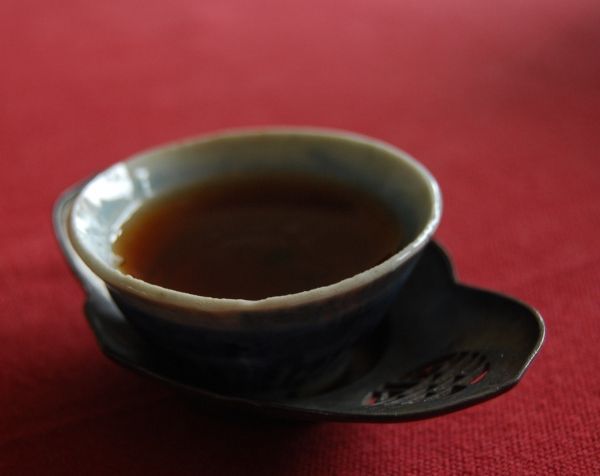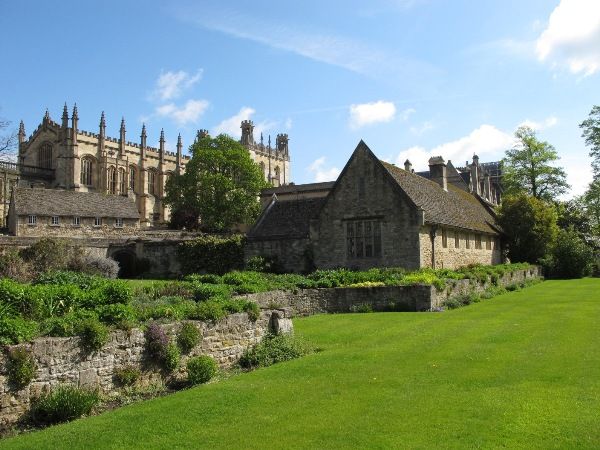I never, ever drink alone. Even if there are no people around, then I drink with Zidu ("purple belly", my teapot) and Qingchang (my three-legged zisha frog). However, people are a bonus.
So, it was a delight to have Prof. GV come to visit, who was in town for a conference. He is as charming as he is bald; i.e., very.
The box of delights
Among his many talents, our Roman visitor and his wife* spend plenty of time buying good tea and teaware in Hong Kong and Taiwan. With quiet happiness, he unveiled his latest acquisitions, brought in a lovely box. I seem to remember that this was a prize from the Wysteria Teahouse in Taiwan, one of Il Professore's favourite haunts.
*Who is Chinese.
Age becomes her
First up, a fifty-year-old treasure in the form of a wulong from Hong Kong's "Best Teahouse", previously sourced from a local herbalist's shop.
I don't want to say "Late Qing", but I think they are, in this case
As if the lovely tea weren't sufficient, some deliciously chubby cups also made an appearance.
If there's one thing I'd love to improve about our teaware, it's the cups. Lei and I spent countless hours searching score upon score of teashops in Maliandao, trying to find good cups, to no avail. While decent tea is common, decent teaware is not. We resolved to wait until we visit Hong Kong or Taiwan ourselves. In the meantime, we enjoyed a lovely session with GV's new set, pictured above.
Like peaches and cream
My qingzi [celadon] gaiwan found its match in this dark, yet surprisingly pine-like, wulong. I don't use my gaiwan enough, but it is a new favourite of mine, bought in Beijing during our recent visit. I like heaviness in teaware, which this gaiwan has in abundance. It takes a long, long time to cool down.
A hush descended
The star of the show then made its appearance: some 1970s "simplified characters" (shown above). The tightly-compressed lump remained together throughout GV's whole visit, and only finally unfurled during extended brewing the next day.
This was a pu'er in which the sensations and chaqi were more dominant than the flavour. It was soothing, calming, and quite reticent. GV noted its granary "crisp-bread" character.
The professor's marvellous cup-trays
I've found that when Lei and I get together with tea-friends, we seldom drink more than three teas. Even after going at it all day this time, we still managed just the three. The third was a "comfort tea": a 1970s Xiaguan shupu brick.
GV's clay kettle (pictured below) worked very well with the shupu. It came from Taiwan, and GV noted that the same variety is being sold by Essence of Tea for less than the cost he encountered in Taiwan.
I appreciated the warmth of the water. My tetsubin, unsurprisingly, gives a certain mineral shine to teas, which I find works best with shengpu.
The lovely Taiwanese kettle did take a long time to boil water, however!
The shupu was extremely comforting, and surprisingly potent. Unlike the 1970s "simplified characters", this really made itself felt.

Tea aside, we also managed a formal dinner at High Table in my college. We have a strict order of precedence. Usually, the junior whelps like me are consigned to the wings of the table, out with the retired, emeritus fellows (who smell of mothballs and
2003 Quanji Bulang). I rather like it like that, because the old duffers are less demanding in conversation. However, bringing a professor as your guest means that you have to sit opposite the Master, right in the middle. Thankfully, there were only ten of us present that night, so it was easy going.
While the media often finds reason to pick on our beleaguered old university, they never seem to argue about the High Table tradition. Some things never change throughout the years, and our twice-weekly dinner ritual is one of them: sherry in the SCR, three courses in the Hall overlooking a room filled with dining undergrads on long benches, before retiring to the Private Dining Room for second-desserts and port. All dressed in knackered old academic gowns.
Some things just don't need modernising...

Plus ca change...
Until next time, professor! Thanks again for a great time.